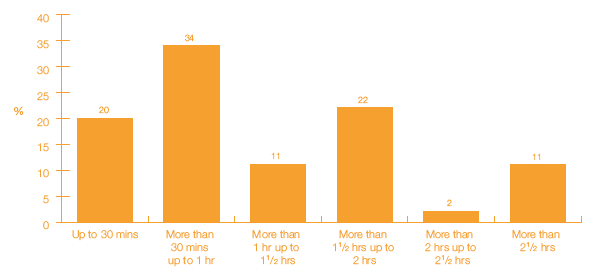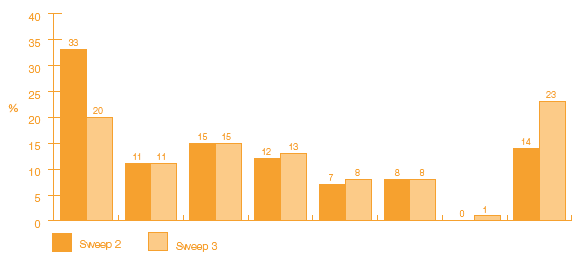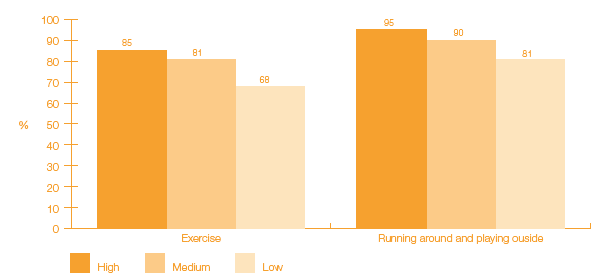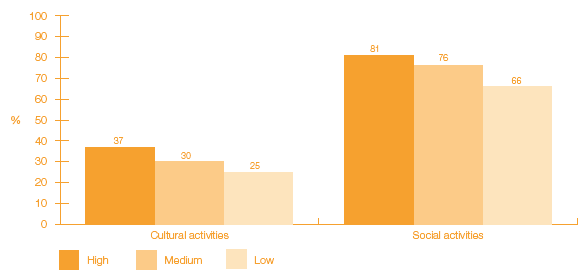Growing Up in Scotland: Sweep 3 Food and Activity Report
This report uses data from the Growing Up in Scotland study to explore the prevalence of, and many issues related to, food and activity in Scotland specifically in relation to young children.
Chapter 3
Pysical and Seentary Activity
3.1 Participation in sedentary and physical activities
The vast majority of children had done some form of physical activity in the week prior to the interview, with two-thirds of children participating in five or more physical activities. These data compare favourably with the Scottish Health Survey results from 2003, which found that 93% of boys and 94% of girls aged 2-4 had done some form of active play on at least one day in the previous week, while 57% and 60%, respectively, had participated in sport and exercise on at least one day (Bromley et al., 2005). The most popular activities were running and/or jumping (99%), throwing or kicking a ball (87%), dancing or gymnastics (64%), riding a bike (62%) and playing at a play/swing park (62%). A further 53% had played on a trampoline and 39% had been swimming in the previous week.
However, time spent engaged in sedentary activity, such as watching TV or playing on
a computer or games console, was also high among children aged just under five. Eighty-five percent of children were reported to have watched TV everyday in the past week, with just 1% having watched no TV. This finding was perhaps not surprising. Perhaps more surprising was the amount of television that children of this age watched on the average weekday. Around half of children were watching under an hour on the average day and half watching over an hour. However, this included over a third who watched more than an hour and a half of TV a day, with one in ten children watching more than two and a half hours of TV a day (Figure 3 A).
Figure 3 A Number of hours of television watched on the average weekday

Base: All children who had watched some TV: weighted - 2242, unweighted - 2295.
In addition, the proportion of children reported to have used a computer or games console in the previous week rose significantly between sweeps two and three (Figure 3-B). Almost a quarter of children were playing on a computer or games console everyday at sweep 3, in contrast to just 14% at sweep 2. The proportions of children who did not do this activity at all fell even more dramatically between sweeps, from 33% to 20%. The amount of time children spend sitting in front of a screen has been found to have a significant relationship with the risk of being overweight or obese in a number of studies. The Survey of sugar intake among children in Scotland, for example, found that for children aged 3-17, a higher proportion of children in the overweight or obese category spent 3 hours or more sitting in front of a screen than those not overweight or obese. Importantly, this study also found that levels of physical activity appeared to have no significant influence on the connection between sedentary activity and BMI (Food Standards Agency, 2008). Wardle et al., (2001), also found that children at higher risk of becoming obese both preferred sedentary pastimes and spent more time engaged in these activities, than lower risk children. The potential relationship physical or sedentary activity and BMI, for children in the GUS cohort will be explored later in section 3.
Figure 3 B Number of days played on computer or games console in the past week

Base: All child cohort: weighted - 2332, unweighted - 2280.
Further investigation was carried out to explore whether the same children who were participating in higher levels of activity were also participating in higher levels of sedentary activity. Children were divided into high, medium and low participatory groups of physical and sedentary activities respectively. It was found that children who did a greater range of physical activities were less likely to have watched television or played on a computer or games console for a substantial amount of time, and the reverse was true of those with the lowest activity levels, as Table 3.1 demonstrates. However, a fifth of children with high physical activity levels also had high sedentary activity levels.
Table 3.1 Physical activity band by sedentary activity band
Sedentary Activity Band |
Physical Activity Band (%) |
||
|---|---|---|---|
Low |
Medium |
High |
|
Low |
24 |
37 |
44 |
Medium |
28 |
29 |
35 |
High |
48 |
24 |
21 |
Bases |
|||
Weighted |
1072 |
487 |
762 |
Unweighted |
1046 |
500 |
778 |
Data from questions on sedentary and physical activities were used to form a combined physical activity score. More specifically, the questions used were:
- The number of days the child had played outside in the previous week
- The number of days the child had played on the computer in the previous week
- The number of hours of TV the child watched on the average weekday
- The amount of time in the previous week spent:
-
- Riding a bike
- Throwing or kicking a ball
- Dancing or gymnastics
- Running and/or jumping
- Playing on a trampoline
- Swimming
- Playing at a soft play area or ball swamp
- Playing at a swing/play park
- Another physical activity
The scale had a range of 0 to 66, with 0 being no physical activity and a large amount of sedentary activity, and 66 being the reverse. The average score was 32, with a minimum score of 5 and a maximum of 58.
3.2 A socio-demographic effect?
As with the food and eating data, there appeared to be a considerable socio-economic divide between highly active and highly inactive children. Those with the lowest activity levels were more likely to be found in the bottom income quintile (28%), and less likely to be found in the highest quintile (12%), in contrast to those children with high activity levels, 16% of whom could be found in the lowest income group compared with 21% in the highest. Although around half of children overall are in managerial and professional households, those children with the highest physical activity levels were more likely to be found in this class (56%) than children in the lowest physical activity group (43%). Again, this was the opposite for those children in routine and semi-routine households. In the lowest activity group, 25% were found in this class, in contrast to 14% in the highest activity group. Family type was found to have no effect, neither did age of mother.
3.3 A neighbourhood effect?
Could the socio-demographic patterns seen above be down to the area these types of households live in and the facilities provided in these areas, rather than to household demographics themselves? Similar, but more extreme, patterns could certainly be seen by area deprivation, with 29% of children with low activity levels living in the most deprived areas, in contrast to 14% who lived in the least deprived areas (Table 3.2). Children with high activity scores were essentially the inverse of this.
Table 3.2 Area deprivation by level of activity
SIMD |
Activity Band (%) |
||
|---|---|---|---|
Low |
Medium |
High |
|
Least deprived - 1 |
14 |
21 |
25 |
2 |
18 |
22 |
23 |
3 |
19 |
21 |
20 |
4 |
19 |
17 |
14 |
Most deprived - 5 |
29 |
20 |
17 |
Bases |
|||
Weighted |
786 |
765 |
675 |
Unweighted |
764 |
775 |
693 |
Highly active children were more likely to live in areas where their parent reported there being 'very good' or 'good' facilities for young children up to the age of 12 (12% and 27%, respectively, of highly active children in contrast to 5% and 24% of inactive children) (Table 3.3). This difference was also reflected with parents' beliefs that their area was good to bring children up in: 21% of children in the high activity group had parents who strongly agreed with this, compared with 12% of children in the low activity group.
Table 3.3 Perception of facilities for young children by Activity Band
Rating of local facilities for young children |
Activity Band (%) |
||
|---|---|---|---|
Low |
Medium |
High |
|
Very good |
5 |
10 |
12 |
Good |
24 |
26 |
27 |
Average |
30 |
29 |
31 |
Poor |
29 |
27 |
23 |
Very poor |
12 |
8 |
7 |
Bases |
|||
Weighted |
786 |
775 |
685 |
Unweighted |
766 |
784 |
703 |
Furthermore, highly active children were more likely to have parents who felt that social and leisure facilities in their area were 'very good' (for people like themselves): 15% of respondents with children in the highest activity band rated these facilities as 'very good', in contrast to just 8% of respondents with children in the lowest activity group. As will be explored in section 3.4, children who had parents who were active themselves, were also likely to fall into the high activity group.
Access to a car appeared to have an impact on the activity levels of the child, although not in the direction that may be expected. It was interesting to note that, at a time where there is a general concern about children being driven everywhere rather than walking, having continuous access to a car was related to increased activity levels. A quarter of children in the lowest activity group had no access to a car in comparison with 12% of children in the highest activity group.
3.4 An attitudinal effect?
If household demographics and the impact of the area are only having some influence, could it be that parental attitudes and example-setting complete the picture of why some children are more active than others? At sweep 2, parents were asked how happy they were with the range of activities their child had access to. Not surprisingly, those children who were very physically active at sweep 3, were more likely to have parents who reported being very happy with the range of activities that their child had access to (28%) than those children in the low physical activity group, where 17% had parents who were very happy with the range of activities the child had access to (Table 3.4).
Perhaps unsurprisingly, it also appears that parental education, and beliefs about the importance of physical activity, also have an impact on the activity levels of the cohort child. Those in the highest physical activity group were far more likely to have a parent with Higher grades or above (81%) than those in the lowest physical activity group (67%).
Table 3.4 Respondent satisfaction with activities provided in area (at sweep 2) by child's activity band (sweep 3)
Satisfaction with range of activities |
Activity Band (%) |
||
|---|---|---|---|
Low |
Medium |
High |
|
I am very happy with the range of activities that my child has access to |
17 |
19 |
28 |
I am quite happy with the range of activities that my child has access to |
35 |
36 |
33 |
I would like my child to have access to a slightly wider range of activities |
29 |
29 |
25 |
I would like my child to have access to a much wider range of activities |
18 |
16 |
15 |
Bases |
|||
Weighted |
780 |
762 |
673 |
Unweighted |
758 |
771 |
690 |
Belief in the importance of physical activity for children was generally high amongst all parents, however, those children in the highest physical activity group were far more likely to have a parent who thought that taking part in exercise was very important (85% vs. 68% in the lowest physical activity group) and that it was very important that the child got to run around and play outside (95% vs. 81%), as Figure 3 C demonstrates. The very small percentage of parents who felt that either of these activities were unimportant all had children in the lowest physical activity group.
Figure 3 C Percentage of children in each activity band whose parents felt exercise or running around and playing outside was 'very important' for the child

Base: All child cohort: weighted - 2226, unweighted - 2231.
In addition, parents of children who were most physically active were also more likely to have reported believing that other experiences such as participating in cultural activities and social activities were very important, as can be seen in Figure 3 D.
Figure 3 D Percentage of children in each activity band whose parents felt cultural or social activities are 'very important'

Base: All child cohort: weighted - 2226, unweighted - 2231.
Parents of highly active children tended to report being socially active themselves with their child. Seventeen percent of those who had a child in the high activity group were active members of a local group set up for parents and children, in comparison with 10% of those with relatively inactive children.
Parents of more active children also reported more frequent participation in informal activities with their child. For example, around half of the children in the highest activity group who ran around and played outdoors during the previous week had done so with their mother (49%), in contrast to just a quarter in the lowest activity group (25%). It was particularly striking that three-quarters of children in the lowest activity group had not run around or played outside with their mother in the week prior to the interview.
These findings seem to point to of the emergence of a type of 'active family', whereby parents who support their child participating in physical activity, are socially active themselves with the child and dedicate time to spending time as a family. Indeed, the view that mealtimes give the family time to talk to each other was also related to the child's activity levels. Children in the highest activity group were more likely to have a parent who reported that mealtimes 'mostly' gave the family time to talk to each other (59%) than those children in the lowest activity group (47%). The frequency of the family eating together and activity level was not found to be significant, though this is likely to be due to the high levels of families eating together on a daily basis.
Table 3.5 Frequency of mealtimes giving family time to talk to each other by activity band
Frequency of which mealtimes |
Activity Band (%) |
||
|---|---|---|---|
Low |
Medium |
High |
|
Never |
6 |
4 |
2 |
Occasionally |
19 |
15 |
13 |
Quite often |
27 |
30 |
26 |
Mostly |
47 |
41 |
59 |
Bases |
|||
Weighted |
805 |
782 |
690 |
Unweighted |
783 |
791 |
708 |
There is a problem
Thanks for your feedback